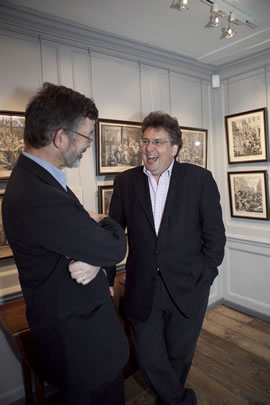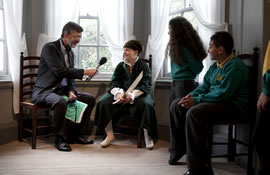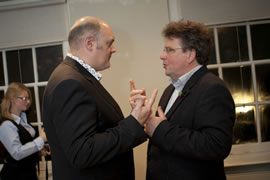Hogarth House Opens to the Public
Dara O Briain cuts the ribbon as restoration finishes on time for artist's 314th birthday
One of the country's cultural landmarks -in the heart of Chiswick - reopens to the public today (Tuesday, November 9th).
Queues had begun to form outside the William Hogarth house as the doors were thrown open to the public at noon having been closed for the past two years for a major £400,000 restoration. The 18th- century house, which was badly damaged in a fire two years ago, has been lovingly restored and a new imaginative approach blends period detail with modern museum innovation.
To the delight of the Hogarth Trust, which spearheaded the project with Hounslow Council and a team of contractors, architects, 18th century specialists and volunteers, the house is being open just shy of Hogarth's 314th birthday and many artefacts have returned to their original home - some after an absence of 200 years.
Chiswick resident, comedian and satirist Dara O Briain, who performed the official opening paid tribute to Hogarth's gift for satire which had endured throughout the years. The beauty of the house was that it enabled people to be transported back in time he added.

Lars Tharp (BBC Antiques Roadshow ceramics expert, and Hogarth Curator of Foundling Museum) jokes with Nick Higham at Hogarth's House.
The house, which is adjacent to the busy Hogarth roundabout on the A4, was purchased in 1749 as a country retreat for Hogarth and his wife Jane, an escape from the grime and noise of Georgian London's Leicester Square where his printing business was based. But the Hogarths also arrived to the riverside village of Chiswick at a time when it was popular with artists and writers. Hogarth had a painting room at the bottom of the walled garden.
According to museum and heritage consultant, Val Bott, who is chair of the Hogarth Trust and a driving force behind the renovation, the public had longed for a museum which displayed, not only prints and paintings, but gave them a feeling for what it was like to live in the 18th century. This motivated the team to seek out personal artefacts and information, not only about William Hogarth but his family members and even the colourful characters who inhabited the house prior to, and after the Hogarth family. These included a Reverend Carey, a poet and curate at St. Nicholas Church, a Lutheran pastor named Ruperti, and an actor, Brayvo Hicks, who was famous for melodrama.
In the newly-restored house people can , as Val Bott puts it "literally wander in Hogarth's shoes". Children will be encouraged to try on exquisitely detailed 18th century suits of clothing,and while the house continues to inform about the painter's contribution to art, morality, and philanthropy with displays of his prints and paintings, visitors will now also find out about the women in Hogarth's life- his wife, her cousin Mary Lewis ( to whom the house was left), his mother-in-law Mary Thornhill, and his sister Anne. The women carried on living in the house after Hogarth's death and it stayed in the family until 1808.

Children from the William Hogarth School, Chiswick are interviewed by the BBC's Nick Higham (for the Today programme)
Hounslow Council which owns the property, will continue to operate free admission for visitors for six days a week from 12-5 p.m. and a team of volunteers will help outreach officer John Collins.
Two floors of the house are open to visitors - the ground floor room to the left of the entrance hall holds displays and computers can give a virtual tour of the house - this will enable those with mobility problems unable to mount the steep stairs to view the upstairs rooms which include bedrooms and a room with a bay window which was possibly used by the ladies of the house for tea parties and sewing. New display cabinets also show family possessions, such as Hogarth's painting chest, a mourning ring for Jane Hogarth, and examples of 18th century pottery and artefacts. The Royal Academy has loaned Hogarth's palette which had been used by JMW Turner.
The intensive renovation work - which received two-thirds of its funding from the Heritage Lottery - was the first full refurbishment in 60 years, following the fire which badly damaged the property in 2009. For this latest project, ancient panelling was repaired, fire-places opened, wooden floor boards uncovered and a set of shutters in the 1750-51 extension were made to work again. A careful paint analysis by Richard Ireland, an Irish expert in Georgian colours, was undertaken to uncover the true colours of the original house and these colours - muted greys and pinks- were sourced and mixed to be brought back into use.
Copies of portraits of Hogarth's sisters, sent from Yale, in the USA,and portraits of his servants, have also been hung.
The house has had a chequered history - surviving bomb damage in the 1940s and then the infamous fire. Restoration work had been completed by the end of July 2009, and the contractors had left the site. Work was progressing on planning the new interpretation scheme when in mid August a fire broke out in the cupboard under the staircase where the electricity supply enters the House. Fortunately damage was minimised by the swift action of the Chiswick firemen and no-one was hurt.
William Hogarth was born in Bartholomew Close, London in 1697, the son of a Latin teacher who was jailed for debt. He became one of the most renowned social satirists of the 18th century and was Sergeant Painter to the King. He was also a talented engraver and observer of the society around him, using his art to draw attention to social issues such as poverty, drunkenness, political corruption and cruelty to children and animals. In 1752 Hogarth published his theoretical book about art, The Analysis of Beauty.
His print series including The Rake's Progress, and Marriage A La Mode, and brutal images such as Gin Lane, are avidly collected and inspiring artists and cartoonists to this day. He was married to Jane Thornhill , daughter of the wealthy society artist Sir James Thornhill ,and although they had no children, they regularly fostered and he was a Governor of Captain Coram's Foundling Hospital in London. Legend has it that Mrs. Hogarth used to make pies for the children from the mulberry tree in the garden of their home in Chiswick - the tree, which is part of the original orchard - still survives.
Hogarth died in London on 26 October 1764 and was buried at St. Nicholas's Churchyard, Chiswick Mall, Chiswick, London.
At a packed opening ceremony on Monday evening, which was attended by the Mayor of Hounslow Councillor Amrit Mann, and the head of the Heritage Lottery Fund, Wesley Kerr, who described Hogarth as a "quintessential London artist, a genius chronicler of people and society."
Thanks were conveyed from Val Bott to all those involved in the project, including the contractors, Laing, and the architects Acanthus L.W, as well as Wyndham Westerdale who is the conservation architect for the firm. She also thanked the project steering group, Hounslow Council, and Chiswick Fire Brigade for saving the house.
For opening hours and further information: www.hounslow.info/arts/hogarthshouse or ring 020 8994 6757.
November 9, 2011
Related links
|
